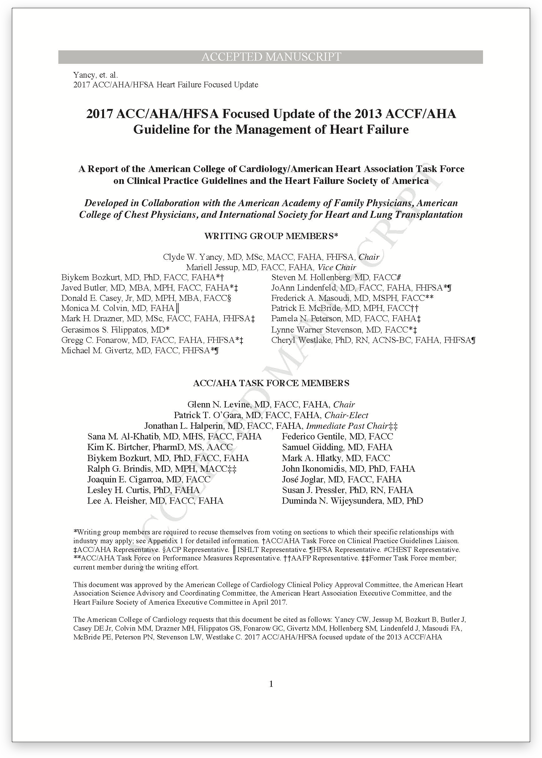The 2017 ACC/AHA updated Guidelines for the Management of Heart Failure recommend BNP or NT-proBNP testing for aiding in HF prevention. 2
With the US population aging, prevalence of heart failure (HF) is projected to grow by 25% and associated direct costs by 215% by 2030.1
BNP and NT-proBNP: not just for diagnosis and management anymore
The natriuretic peptide (NP) biomarkers, B-type natriuretic peptide (BNP), and N-terminal pro B-type natriuretic peptide (NT-proBNP), which play a role in myocardial stress, have long served as clinically useful markers for heart failure diagnosis and management. New data and guidelines suggest that for patients at risk of developing HF, NP biomarker–based screening followed by team-based care, including a cardiovascular specialist optimizing guidelinedirected medical therapy, may be useful to prevent the development of new-onset HF.2 This means more people may benefit from BNP and NT-proBNP testing.
HF biomarker testing from Quest Diagnostics3
| Biomarker | Prevention | Diagnosis | Prognosis | Therapy guidance |
| BNP | ++++ | ++++ | ++++ | ++ |
| NT-proBNP | ++++ | ++++ | ++++ | ++ |
| sST2 | + | ++++ | N/A | |
| Galectin-3 |
+++ | N/A |
Prevention: backed by clinical guidelines

Which patients warrant extra vigilance for heart failure risk?
- Patients who may be at risk for developing heart failure include those with:
- Poorly controlled hypertension
- Diabetes
- Known vascular disease
In addition, risk identification may serve as a wake-up call for patients of concern, e.g., those not adhering to medications or otherwise not following their treatment plan.
Enhance risk stratification
Once diagnosed with chronic heart failure, a patient may be tested for other markers to help identify whether they are at elevated risk of disease progression:
sST2 (ST2) is a soluble isoform of ST-2, an interleukin-1 receptor family member that is elevated in some inflammatory diseases, including HF. Patients with heart failure and elevated sST2 levels are at increased risk for heart failure progression, rehospitalization, heart transplantation, and death.4-5 ACCF/AHA guidelines recommend measurement of sST2 for additive risk stratification in patients with acute or chronic heart failure.7,8
Galectin-3 is a carbohydrate-binding lectin that increases collagen production and cardiac fibroblast proliferation. Elevated levels of galectin-3 have been associated with macrophage infiltration, cardiac fibrosis, and cardiac hypertrophy, which contribute to progression of heart failure and poor cardiovascular outcomes. Measuring galectin-3 in conjunction with BNP/NTproBNP and ST2 may further enhance risk stratification to monitor and treat HF and CVD.
Trust Quest Diagnostics for your cardiometabolic testing needs
From heart failure testing to diagnosis and monitoring, our test menu and related services can support you and your patients across the continuum of care.
Heart Failure biomarker testing from Quest
| Test Name | Clinical Use |
| B-Type Natriuretic Peptide (BNP) | Screen for heart failure risk Diagnose heart failure Help predict outcomes in patients with heart failure Help guide pharmacologic treatment of patients with heart failure |
| NT-proBNP | Screen for heart failure risk Diagnose heart failure Help predict outcomes in patients with heart failure Help guide pharmacologic treatment of patients with heart failure |
| Cardio IQ® NT-proBNP | Screen for heart failure risk Help determine risk of heart failure in patients with stable coronary heart disease |
| Cardio IQ® ST2, Soluble | Help predict outcomes in patients with heart failure |
| Cardio IQ® Galectin-3 | Help identify individuals with chronic heart failure |
This information is provided for informational purposes only and is not intended as medical advice. A physician’s test selection and interpretation, diagnosis, and patient management decisions should be based on his/her education, clinical expertise, and assessment of the patient.
References
- Konstam MA. Home monitoring should be the central element in an effective program of heart failure disease management. Circulation. 2012;125:820-7.
- Yancy CW, et al. 2017 ACC/AHA/HFSA focused update of the 2013 ACCF/AHA guideline for the management of heart failure. Circulation. 2017;CIR.0000000000000509. doi: https://doi.org/10.1161/CIR.0000000000000509.
- Adapted from van Kimmenade RRJ and Januzzi JL. Emerging biomarkers in heart failure. Clin Chem. 2012;58(1):127-138.
- Ky B, French B, McCloskey K, et al. High-sensitivity ST2 for prediction of adverse outcomes in chronic heart failure. Circ Heart Fail. 2011;4:180-187.
- Ky B, French B, Levy WC, et al. Multiple biomarkers for risk prediction in chronic heart failure. Circ Heart Fail. 2012;5:183-190.
- Rehman SU, Mueller T, Januzzi JL Jr. Characteristics of the novel interleukin family biomarker ST2 in patients with acute heart failure. J Am Coll Cardiol. 2008;52:1458-1465.
- 2013 ACCF/AHA guideline for the management of heart failure. J Am Coll Cardiol. 2013:62(16);e147-e239.
- Bayes-Genis A, Zhang Y, Ky B. ST2 and patient prognosis in chronic heart failure. Am J Cardiol. 2015;115:64B-69B.
Questions?
Your Quest account representative can provide additional information on our cardiovascular testing solutions.
Earlier identification of heart failure risk
Earlier identification of heart failure risk
-
Advanced lipid testing -
Identifying residual risk -
Inflammation testing -
Advanced inflammatory marker testing -
Metabolic testing -
Metabolic testing portfolio -
Cardiogenetic testing -
Heart failure -
Focus on earlier identification of heart failure risk -
Non-lipid markers for CVD -
Important genotyping -
CVD test descriptions -
4myheart® program -
Cardio IQ® report -
Early identification of CVD risk in women






